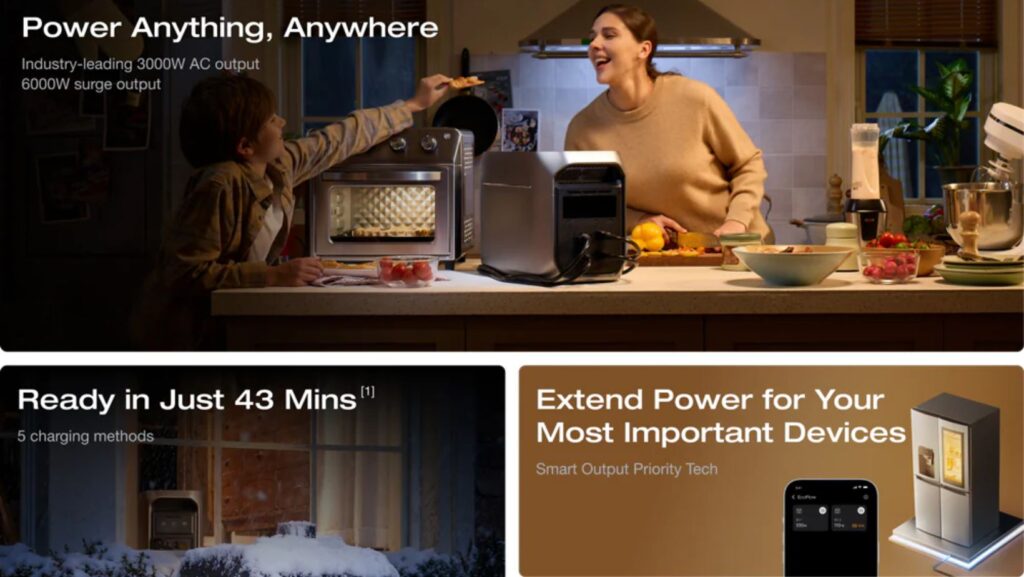
Every Canadian winter tells the same story: snowstorms, freezing rain, and power outages that leave neighborhoods in the dark. Losing electricity isn’t just inconvenient—it can quickly become dangerous in subzero conditions. Heat, water pumps, and communication systems all depend on a stable power supply. Preparing ahead of time is the only way to stay safe and comfortable when the grid goes down.
One increasingly popular solution across the country is the solar generator—a clean, reliable backup power source that can keep your home running even during extended blackouts. But it’s only one part of a comprehensive plan. Let’s explore how to get your home truly ready for the challenges of a Canadian winter.
1. Understand Why Power Outages Are Common in Canadian Winters
From British Columbia’s coastal storms to Quebec’s ice-laden power lines, outages are part of the national experience. Freezing rain can coat cables with thick ice, heavy snow can break branches onto lines, and extreme cold can overload local grids as demand for heating surges.
In rural areas, repairs may take days. In cities, the issue may be shorter but more frequent. That’s why preparedness isn’t a luxury—it’s essential. Having a solar generator as part of your emergency kit can make the difference between discomfort and true resilience.
2. Evaluate Your Home’s Critical Power Needs
Before investing in backup power, calculate what you truly need to keep running during an outage. Start with essentials:
- Heating: Electric heaters, pellet stoves, or oil furnaces with electric fans all draw considerable power.
- Refrigeration: Preventing food spoilage can save hundreds of dollars.
- Lighting: LED bulbs use little energy but provide comfort and safety.
- Communication: Wi-Fi routers, phones, and laptops are vital for updates and emergency contact.
- Medical devices: If anyone in your household relies on electric medical equipment, backup power is non-negotiable.
Once you know your daily watt-hour requirement, you can choose the right capacity of solar generator to sustain these essentials for a given duration—say, one to three days without grid power.
3. Why Solar Power Works Even in Canadian Winters
A common misconception is that solar power doesn’t function in cold weather. In reality, solar panels often perform better in low temperatures. What matters is sunlight—not heat.
Even on cloudy days, panels generate energy through diffuse light. And modern solar generators use high-efficiency MPPT (Maximum Power Point Tracking) controllers that extract the most power possible from limited sunlight.
Moreover, lithium iron phosphate (LFP) batteries—the backbone of today’s portable solar systems—are engineered to operate safely in subzero conditions. When combined with smart energy management, a properly sized system can recharge even on short winter days.
4. Build a Layered Backup Power Strategy
Relying solely on the grid is risky. The best approach is to create layers of protection:
- Primary Backup: A solar generator provides renewable energy without noise or fumes.
- Secondary Backup: Battery banks or portable power stations for quick plug-and-play use.
- Emergency Charging: Car inverters or small gas generators (used outdoors only) as last-resort options.
This multi-tiered setup ensures that if one method fails, another is ready. A solar generator is ideal for silent indoor operation, while other options can supplement when solar input is low.
5. How to Choose the Right Solar Generator for Winter Use
Selecting the right equipment depends on your home’s size, climate zone, and typical outage duration. Here’s what to look for:
a. Battery Capacity
Measured in watt-hours (Wh) or kilowatt-hours (kWh). A small household might get by with 2 kWh, while larger homes may need 5–10 kWh or more to keep essential systems running for multiple days.
b. Output Power
Continuous output defines how many devices you can run simultaneously. Look for at least 1500–3000 W to handle common household items like refrigerators or space heaters.
c. Solar Input and Expansion
Higher solar input (1000–2000 W or more) means faster recharging during daylight. Choose a system that allows expansion with extra panels or batteries.
d. Cold-Weather Compatibility
Ensure the solar generator uses LFP batteries and includes thermal management for charging in low temperatures. Some systems feature built-in heaters or insulated housings for better winter efficiency.
e. Portability and Safety
Select a model that’s compact yet powerful, with indoor-safe operation and robust protection against overcharge, short circuits, and overheating.
6. Setting Up Your Home for Winter Power Resilience
A strong backup system starts with smart planning. Follow these steps to prepare:
Step 1: Designate an Emergency Power Zone
Choose a central room where your solar generator and critical devices will be stationed. Keep blankets, first aid kits, and battery-powered lights nearby.
Step 2: Connect Key Appliances
Use heavy-duty extension cords or transfer switches (installed by certified electricians) to power crucial circuits like heating, lighting, and refrigeration. Always follow local electrical codes.
Step 3: Install Solar Panels Safely
Mount portable panels near windows, balconies, or outdoor areas with the best sun exposure. Clear snow frequently to maintain output efficiency.
Step 4: Store Energy in Advance
Before storms hit, charge your solar generator fully via AC or solar input. This ensures instant readiness if grid power drops.
Step 5: Test Regularly
Run a simulation every few months—unplug from the grid and practice using your system. This builds confidence and identifies weak spots before emergencies strike.

7. Smart Energy Management During a Blackout
Even the most efficient solar generator has limits, so managing power wisely extends runtime:
- Prioritize Essentials: Power heating, refrigeration, and communication first.
- Use Low-Watt Devices: LED lighting, induction cooktops, and efficient laptops save energy.
- Avoid High-Drain Appliances: Electric kettles, hairdryers, or microwaves can deplete batteries quickly.
- Monitor Output: Many systems come with mobile apps that track usage and remaining charge in real time.
- Recharge When Possible: Even partial sunlight during midday can significantly extend available energy.
8. Additional Home Preparations for Winter Outages
While backup power is central, other measures increase safety and comfort:
- Insulate Windows and Doors: Reduce heat loss with weather stripping and thermal curtains.
- Stock Non-Perishable Food and Water: Aim for at least three days’ supply.
- Maintain Heating Alternatives: Propane stoves, wood burners, or kerosene heaters can supplement when used safely.
- Protect Plumbing: During extended outages, open faucets slightly to prevent freezing.
- Check Carbon Monoxide Detectors: Ensure detectors are functional, especially if using fuel-based heat sources.
- Keep Emergency Communication Devices: Battery radios or satellite messengers are valuable if mobile service fails.
These steps complement your solar generator setup, making your household truly resilient.
9. Comparing Solar vs. Gas Backup Options
| Feature | Solar Generator | Gas Generator |
| Fuel Source | Sunlight | Gasoline or propane |
| Noise Level | Nearly silent | Loud, requires outdoor use |
| Maintenance | Minimal | Requires oil and filter changes |
| Operating Safety | No fumes, indoor-safe | Carbon monoxide risk |
| Long-Term Cost | High initial cost, low maintenance | Low upfront, continuous fuel cost |
| Environmental Impact | Zero emissions | High emissions |
For homeowners prioritizing sustainability and indoor safety, the solar generator stands out as the clear long-term solution.
10. Benefits That Go Beyond Emergency Use
The appeal of a solar generator doesn’t end when the power returns. Many homeowners use their systems year-round for outdoor activities, RV travel, or as part of a broader solar energy setup. Some connect their units to rooftop solar arrays to offset daily electricity use or power garden sheds and remote workstations.
This flexibility turns a one-time investment into an ongoing energy asset—helping you save money and reduce reliance on fossil fuels.
11. The Future of Home Energy Independence in Canada
Canada’s energy landscape is shifting toward decentralization. Homeowners are embracing self-sufficient solutions that blend renewable energy with smart technology. Modern solar generators reflect this movement—compact, AI-managed, and expandable.
As climate events grow more severe, governments and provinces are encouraging households to strengthen their emergency preparedness. By investing in clean, portable energy now, Canadians can stay powered through storms and contribute to the country’s sustainability goals.
Conclusion
Winter in Canada is as beautiful as it is unforgiving. Power outages are inevitable—but being unprepared doesn’t have to be. A well-chosen solar generator, paired with practical home upgrades, can keep your family safe, warm, and connected through any storm.
Clean power, quiet nights, and peace of mind—that’s the new definition of Canadian winter readiness.












